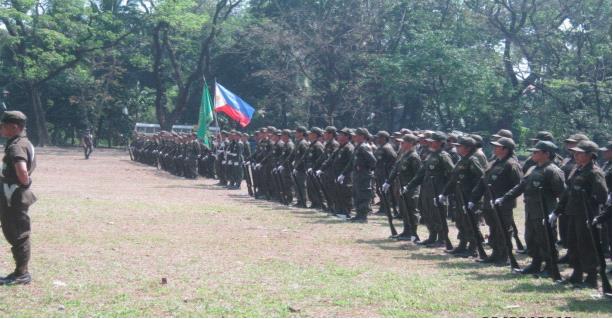(First of Three Parts)

Brief History of the ROTC Program in the Philippines
The Reserve Officer Training Corps (ROTC) program traces its humble beginnings in December 1935 with the passing of Commonwealth Act No. 1, better known as the National Defense Act, which mandates the creation of a citizen army composed of a small regular force and a larger reserve component. All able-bodied male students enrolled in Philippine colleges and universities were required to undergo two years of basic military instruction under this program.
The University of the Philippines cadet corps is known to have pioneered the ROTC program in the Philippines in 1912 when Philippine Constabulary officers started providing military instructions at UP. But even earlier than the UP ROTC was a program organized at the University of Santo Tomas in 1762 by its chancellor, Fr. Domingo Collantes. A battalion of young students were given military training to help fight invading English troops.
Part of the “birth pains” in the organization of the Philippine Army, as provided for by the National Defense Act, was the creation of a satisfactory officer corps. The Philippine Constabulary had good officers but their training lay in law enforcement rather than in military tactics and strategy. The problem was to train junior officers to command the reserve units that were being formed. Senior ROTC units were established to provide the junior reserve officers who would head this large component of our defense establishment.
By 1941, there were 33 colleges and universities throughout the country maintaining ROTC units. World War II saw ROTC products in action for the first time. Cadets from Metro Manila units took part in the defense of Bataan. In the Visayas, 45 percent of the 75th Infantry Regiment of the United States Armed Forces in the Far East (USAFFE) were ROTC cadets of Silliman University. Graduates of the Philippine Military Academy and various ROTC units formed the Hunters ROTC guerrillas that continued the fight after the surrender of Bataan and Corregidor.
In 1967, President Ferdinand Marcos issued Executive Order No. 59, making ROTC a mandatory course in all colleges and universities with an enrollment of at least 250 male students. A noteworthy development during this period was a program called “Rainbow Rangers-Sunday Soldiers.” It provided an alternative to what was basically a ceremony-centered ROTC training program. It exposed the cadets to small unit tactics, unconventional warfare and home defense techniques.
ROTC in Crisis and the Birth of NTSP

However, March 2001 marked a turning point in the post-martial law history of the ROTC when UST Cadet Sgt. Major Mark Welson Chua was abducted and brutally murdered allegedly by members of the UST ROTC training staff following a corruption exposé he made public. A Manila Regional Trial Court handed the death penalty to Chua’s fellow cadet three years later. Chua’s death was considered by many as the catalyst for ROTC reforms.
Republic Act 9163, otherwise known as the National Service Training Program (NSTP) Act of 2001, became Congress’ answer to the clamor for change in the ROTC program. It was promulgated by the 12th Congress of the Philippines on January 23, 2002. Under the NSTP Program, both male and female college students of any baccalaureate degree course or technical vocational course in public or private educational institutions are obliged to undergo one of three program components namely: (1) the Reserve Officer Training Corps (ROTC) which provides military training to tertiary level students; (2) the Literacy Training Service (LTS) which is designed to train students to become teachers of literacy and numeracy skills to schoolchildren; and (3) the Civic Welfare Training Service (CWTS) which refers to activities contributory to the general welfare and the betterment of life for members of the community, for an academic period of two semesters. However, ROTC as a pre-requisite for graduation was rescinded. The program aimed at enhancing civic consciousness and defense preparedness in the youth, by developing the ethics of service and patriotism. State Universities and Colleges (SUCs) and other institutions of higher learning are required to offer the ROTC and CWTS Program. A Department of Military Science and Tactics (DMST) may be established provided that there are 350 cadets. The Philippine Military Academy (PMA), PMMA (Philippine Merchant Marine Academy), and other SUCs of similar nature need not abide with the newly established act. Even though this act did not affect the Citizens’ Army Training (CAT) in high school, CAT was thereby made also optional for the intermediate schools to operate and/or provide to high school students.
This act subsequently amended RA 7077 which provided for the development, administration, organization, training, maintenance, and utilization of the citizen armed force of the Armed Forces of the Philippines. RA 7077 requires a mandatory military training which included the ROTC for students enrolled in colleges, universities, and similar institutions of learning pursuant to the provisions of the National Defense Act and the 1987 Constitution.
ROTC as a Component of NSTP and its Challenges
The Reserve Officers’ Training Corps (ROTC) as defined in the Implementing Rules and Regulations (IRR) of the NSTP “refers to the Program component institutionalized under Sections 38 and 39 of RA 7077, designed to provide military training to tertiary level students in order to motivate, train, organize, and mobilize them for national defense preparedness.”
The IRR, which took seven years to be adopted and issued after the signing of RA 9163 into law in 2002 by then President Gloria Macapagal-Arroyo, clearly requires that “all higher educational institutions including State Universities and Colleges (SUCs) and technical-vocational education institutions must offer upon enrollment all the three (3) NSTP components.
However, State Universities and Colleges (SUCs) are required to maintain and provide the ROTC component. In cases that the enrollment of ROTC cadets is less than 350 then, the provisions of clustering in Section 7 of NSTP IRR should be followed.”
It’s quite clear in the IRR that all colleges and universities including state-owned and technical-vocational schools are mandated to offer all the NSTP components. However, the reality is that this particular provision in the IRR is not being complied by many colleges and universities either deliberately or plain ignorance of the IRR. This was proven true during the ROTC summit facilitated by the National Capital Region Regional Community Defense Group (NCRRCDG) in September 2013 where it was found out that quite a number of college administrators including their respective NTSP coordinators are not aware of the provisions of the NTSP IRR particularly this provision on the ROTC component. What are only offered in a large number of privately-owned colleges are the LTS and CWTS components. This utter lack of appreciation of the NSTP law by the school authorities who are supposed to implement the law has further alienated the ROTC program from our youth.
The continuous decline in the number of ROTC enrollees since the implementation of NSTP Law in 2001 manifests the ever growing disinterest of the youth/student sector to the ROTC program. Case in point is the UP ROTC Unit which boasts being the pioneer and one of the best ROTC units in the country. The UP ROTC Corps of Cadets is a significant source of many prominent officers of the AFP such as Major Ferdinand E Marcos who later became President and Commander-in-Chief of the AFP; General Rigoberto J Atienza, the 9th Chief of Staff of the AFP from 1962 to 1965; General Romeo C Espino, the longest serving Chief of Staff of the AFP from 1972 to 1981; and General Fabian C Ver, the Chief of Staff under President Marcos, to name a few.
Since the implementation of the NSTP in 2001, like other ROTC units, the UP ROTC unit also experienced a rapid decrease in enrollment from an average of more than a thousand enrollees during the pre-NSTP era to just an average 200 enrollees post 2001. The case of UP ROTC unit is comprehensible given the reputation of the state university as training ground for student activism which was further inflamed by the Mark Chua case. As a result, these left-leaning organizations took advantage of the media mileage for their own propaganda against the ROTC program resulting to further deterioration of ROTC’s image among the youth. The stigma left by the Mark Chua case will be difficult to erase unless drastic changes are made in the ROTC program beginning with the review of its Program of Instruction (POI) by making it more relevant to the current national security situation and coming up with a “marketing strategy” that will be attractive to the young generation.
According to the latest available data, there has been a significant reduction in the number of students enrolling in ROTC. From more than 800,000 enrolled cadets during the 1999-2000 school year, ROTC enrollment has dropped to 150,000 as of 2011. During the first quarter of 2011, 500 colleges and universities were participating in the ROTC program. This is a sharp decline from the 200,000 schools offering ROTC before the National Service Training Program was enforced. These are some of the many challenges that our defense establishment is facing in the implementation of the NSTP.
(To be continued)






